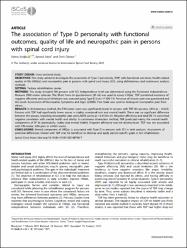The association of Type D personality with functional outcomes, quality of life and neuropathic pain in persons with spinal cord injury

Göster/
Erişim
info:eu-repo/semantics/embargoedAccessTarih
05.02.2022Üst veri
Tüm öğe kaydını gösterKünye
Eroğlu, S., Solak, S., & Dündar, Ü. (2022). The association of Type D personality with functional outcomes, quality of life and neuropathic pain in persons with spinal cord injury. Spinal Cord, 1-7.Özet
Study design
Cross-sectional study.
Objectives
This study aimed to investigate the association of Type D personality (TDP) with functional outcomes, health-related quality of life (HRQoL) and neuropathic pain in persons with spinal cord injury (SCI), using dichotomous and continuous analysis methods.
Setting
Tertiary rehabilitation center.
Methods
This study included 105 persons with SCI. Independence level was determined using the Functional Independence Measure (FIM)-motor subscale. The Short Form-36 questionnaire (SF-36) was used to assess HRQoL. TDP (combined existence of negative affectivity and social inhibition) was assessed using Type D Scale-14 (DS-14). Presence of chronic pain was questioned and the Leeds Assessment of Neuropathic Symptoms and Signs (LANSS) Pain Scale was used to distinguish neuropathic pain from others.
Results
In dichotomous method, the FIM-motor score was significantly lower in persons with TDP (41 persons, 39%) (p = 0.025). Persons with TDP had significantly lower scores in vitality, emotional role and mental health. There was no significant difference between the groups, regarding neuropathic pain and LANSS scores (p > 0.05 for all). Negative affectivity and total DS-14 scores had negative correlation with mental health and vitality. In continuous interaction method, TDP predicted mainly the mental health components of SF-36 (particularly, vitality and mental health). Negative affectivity was the driving factor. TDP was not associated with FIM-motor, VAS pain or LANSS scores.
Conclusions
Mental component of HRQoL is associated with Type D in persons with SCI in both analyses. Assessment of potential differences related with TDP may be beneficial to develop and apply person-specific goals in SCI rehabilitation.















